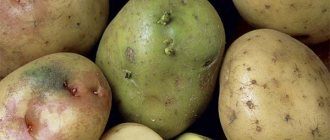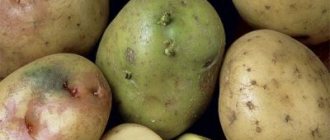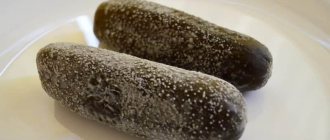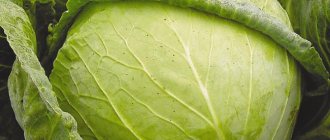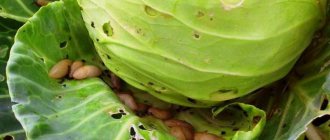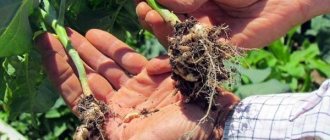What do black dots on cabbage mean and can it be eaten?
It often happens that the crop has already been grown and prepared for storage for the winter.
And you take out a head of cabbage, cut it, and there... A lot of black dots. The first question that arises is where did they come from and what to do with the harvest now.
Let's take a closer look at where these blackheads come from and how to prevent their appearance in the future.
Wet rot, or slimy bacteriosis
The causative agent of mucous bacteriosis is the bacteria Erwinia carotovora subsp. carotovora (Jones) Bergey, Harrison. Mucous bacteriosis of cabbage is a disease that often develops after a sharp change from warm weather (+20-25°C) to rainy cold weather, and primarily on plants damaged by pests or overfed with nitrogen. It is also believed that bacteria can enter cabbage crops with irrigation water. Wet rot most often appears during head setting, first affecting the large petioles of the outer leaves and then spreading to the heads of cabbage.
Areas affected by wet rot become slimy, and an unpleasant fetid odor of rot, characteristic of all bacterioses, appears.
It should be noted that if, when the upper leaves of cabbage heads are affected by mucous bacteriosis, dry weather sets in with low air humidity, then the diseased areas dry out, become thin and transparent.
Sometimes mucous bacteriosis begins to develop from the stump, while it softens and the formation of the head of cabbage stops. With the strong development of mucous bacteriosis, the heads of cabbage fall off the stump before ripening.
Heads of cabbage slightly affected by mucous bacteriosis may seem quite healthy, but sometimes the characteristic smell in cabbage beds gives it away. With timely intervention, it is quite possible to save such heads of cabbage. If nothing is done, then when storing affected heads of cabbage, wet rot causes large losses.
Storing slightly affected heads of cabbage (without visible symptoms of the disease) leads to their further rotting at temperatures above +3...+4°C.
The causative agent of mucous bacteriosis persists in plant debris, in heads of cabbage and in storage rooms, but is not transmitted by seeds. Peduncles do not form on infected heads of cabbage.
If signs of bacteriosis appear on cabbage, nitrogen fertilizing should be avoided. Instead of nitrogen fertilizers, you need to use potassium nitrate: 1-2 tablespoons per 10 liters of water, consumption - 5 liters of solution per 1 m2, moderate watering, when watering it is advisable to pour water only at the root.
Why do blackheads appear?
So, the main reason for the appearance of these unpleasant black dots on cabbage leaves is punctate necrosis. But other diseases - white rot, gray rot, vascular bacteriosis - can also cause an outwardly similar manifestation, subsequently changing.
Pests can also be the cause of their appearance. Sometimes easily removed black spots between cabbage leaves can be the excrement of cabbage or turnip white caterpillars living in them, which not only spoil the cabbage, leaving their waste products on it, but also eat the leaves and damage the heads of cabbage.
Let's take a closer look at plant diseases that cause the appearance of black spots.
- Spot necrosis is a disease characterized by the appearance of black spots on the inner leaves of white cabbage, which are up to three millimeters in size and may be slightly depressed. This disease appears when the heads of cabbage are fully formed, that is, before harvesting.
The reason for its appearance is the excessive application of nitrogen fertilizers. This causes a disruption in the maturation of leaf parenchyma tissues and leads to a kind of point necrosis. As a rule, such spots are subsequently affected by fungal infections, which is why their color may change over time.
During storage, the disease progresses and closer to spring, the leaves of cabbage heads are sometimes simply dotted with black dots. The disease is not initially infectious. It appears as a result of metabolic disorders due to biochemical changes occurring in vegetables.
- Vascular bacteriosis can also cause the appearance of dark spots on the leaves. It also attacks leaves, but these spots appear mainly on the petioles and veins.
- White rot. The lower leaves of cabbage, as well as the root collar, are mainly affected. As a result of the disease, the leaves become discolored in patches and become covered with mycelium.
By the beginning of harvesting, the mycelium becomes dense, and black spots of various shapes appear. The cause of this disease is also excess nitrogen in the soil and its increased acidity.
- Gray rot. Heads of cabbage become infected with it already during storage. Externally, it manifests itself in the partial covering of the cuttings of the lower leaves of the head of cabbage with grayish mold interspersed with small black dots.
Description of the fruit and vegetable crop
Chinese cabbage is a vegetable from the Brassica family, one of the subspecies of turnips. The crop is also called Chinese or lettuce, Chinese lettuce or petsai. When cultivated, it is grown as an annual plant.
Did you know? The homeland of Chinese cabbage is China. The first mentions of the plant are found in written sources of the 5th-6th centuries AD. e.
The vegetable has the shape of a rosette in the form of a loosened head of cabbage. The shape of the vegetable is cylindrical. Cabbage foxtails are wavy, loose, and have jagged or wavy edges. The color of the product is most often light green. There are also yellow and bright green specimens. The product contains vitamins A, C, B1, B2, B6, PP, which are essential for the human body. The leaves also contain up to 3.5% protein.
Prevention and treatment
Spot necrosis appears on cabbage leaves due to disturbances in plant nutrition during growth and ripening. This usually happens when there is too much nitrogen in the soil. Further, the development of this disease is facilitated by improper storage conditions.
To prevent the appearance of black spots on cabbage, the following conditions must be observed:
- Follow agricultural practices for cultivating crops and regulate the application of fertilizers. Preference should be given to phosphorus-potassium fertilizers, as well as those containing boron and molybdenum.
- It is also necessary to reduce soil acidity by liming or adding wood ash. These agrotechnical measures will reduce the possibility of spot necrosis on cabbage, prevent the appearance of white and gray rot, and vascular bacteriosis.
- To combat turnip or cabbage whites, you need to weed the plantings in time. When caterpillars appear, spray with a decoction of wormwood or celandine.
- Use necrosis-resistant varieties of white cabbage, such as Zimovka 1474, Amager 614, Slava 1305 and others.
- Harvesting should be carried out in dry weather. The heads of cabbage must be mature. Vegetables without visible signs of disease are stored for storage.
- Optimal storage conditions for the culture must be observed. The air in the storage room must be well ventilated. It is advisable to maintain the temperature within 0 – 1˚С, humidity 85 – 90%. Heads of cabbage during storage should be checked and if diseases of white or gray rot, as well as vascular bacteriosis, appear, remove the leaves and trim the stalk.
In conclusion, I would like to note that by strictly observing the agricultural technology of cultivating the crop and the storage conditions of the crop, the percentage of damage to cabbage heads will be significantly reduced.
How to properly store cabbage?
If you want to harvest cabbage for long-term storage throughout the winter, then pay attention to the keeping quality of a particular variety in advance. Mid-season and late-ripening varieties of cabbage are best stored (at a minimum, they will have to lie in the cellar much less). Early cabbage has a loose head, so it is not suitable for long-term storage (mold and rot easily form inside).
Among the late varieties, the following are ideal for long-term storage:
- Moscow.
- Wintering
- Golden hectare
- Nadezhda, etc.
As a rule, the manufacturer indicates on the packaging the main characteristics of a particular variety, and if the head of cabbage is suitable for long-term storage in the cellar, this will be indicated on the seed packaging.
In order for cabbage to be stored for a long time, it is necessary to comply with technology standards not only during storage, but also already at the harvesting stage. The following tips will help you avoid diseases during storage.
Harvest correctly
Cabbage is harvested from the field on a sunny day without precipitation. Each head is dug out with a shovel. Do not immediately cut off the roots and stumps; clean them of adhering soil. Immediately remove cabbage that is not suitable for storage, remove dried or damaged leaves. The head must be solid and dense, this is the only way it will last a really long time.
Before transferring the collected heads to the cellar, the cabbage is pre-dried for several days.
Conditions in the cellar
If you will store a large amount of cabbage in the basement, then you need to first take care of the microclimate in the room. It is necessary to ensure the temperature is at zero degrees, and the humidity is about 95%. In such conditions, the heads do not freeze, and favorable conditions for the development of the cabbage diseases described above are not created.
All surfaces in the basement or cellar must be treated with an antiseptic solution; make sure that rodents do not have access to the room. In general, the room should be clean, without debris, remnants of last year’s cabbage or other vegetables.
Cabbage can be stored in the cellar in several ways:
- In boxes. To use this method, you just need to cut off the stump and remove the damaged leaves. The boxes must have holes at the bottom (or be wooden). The cabbage is not covered with a lid; the boxes themselves are placed not on the floor, but on a stand. This way, air circulation prevents the development of fungal diseases and rot.
- Pyramid. The vegetables are laid out in a pyramid on a small stand - again, it is not recommended to place vegetables on the floor, as proper air circulation will not be maintained. This method ensures excellent air circulation, since the next layer of cabbage is laid out on top of the previous one in a checkerboard pattern. Remove cabbage from the top layer for consumption.
- Under the sand. The cabbage is placed in wooden boxes and covered with sand. They say that it is with this method that the maximum amount of nutrients in cabbage is preserved.
- Paper wrapper. This is only suitable if you have not harvested too much harvest - you need to wrap each head of cabbage in paper. Old newspapers will do, but it's better to use craft paper without ink. You can wrap the head of cabbage in several layers.
- Cling film. The good thing about this method is that each head of cabbage is isolated from the others, which means that you reduce the risk of developing fungal diseases that are transmitted through the air through spores.
- On a rope. With this method, you can only store up to 20-30 forks of cabbage. You need to nail a wooden board to the ceiling, drive nails into it and secure the heads of cabbage so that they do not touch each other. This method is considered environmentally friendly and safe, but is not justified from an ergonomic point of view.
Why do they form on leaves?
Black dots are characteristic of 3 conditions at once. This may be a physiological disorder of the crop associated with improper growth conditions and excess nutrients in the soil. Dark specks are a symptom of some diseases , as well as a sign of pests “invading” Beijing.
- One of the main causes is a physiological disorder or punctate necrosis. Occurs due to metabolic disorders in cabbage. Reason for appearance:
- soil alkalization;
- excess nitrogen and phosphorus.
Affects mature heads of cabbage before harvesting. It also affects the heads during storage and progresses quickly - by spring, the leaves of the Pekin plant are literally dotted with small black dots.
- In second place in terms of frequency of occurrence is Alternaria . This is a fungal disease that develops in conditions of high humidity. It can affect cabbage at the seedling stage - dark stripes and spots appear on the leaves. On adult plants, in addition to black spots, a sooty coating forms on the leaves, which contains conidia of the fungus. The “incubator” for infection is plant debris and unharvested weeds. The pathogen is also carried by pests.
- Other probable causes of blackheads: Infestation with cabbage flea beetle. Initially, the dots have a transparent grayish tint, but over time they turn black.
- Infection with cabbage whites. Black dots between the leaves are traces of pest excrement.
- Vascular bacteriosis. Dark spots appear on the veins and petioles of leaves.
- White rot. The lower leaves and root collar are affected. Peking leaves become discolored over time and become covered with mycelium.
- Gray rot. Develops during storage. The lower leaves of the cabbage are partially covered with grayish mold and are interspersed with small black dots.
Why is eating such cabbage dangerous?
Do not ignore the above advice - small putrefactive spots or wilted leaves can cause severe food poisoning.
The main symptoms include:
- stomach upsets;
- vomit;
- sharp pain in the abdomen;
- increase in temperature and pressure;
- weakness.
And such poisoning is especially dangerous for children and pregnant women, so you should be very careful when choosing food products.
Is it possible to eat this Chinese vegetable?
It is not recommended to eat the heads that have black “marks” on them. This is unpleasant to do for aesthetic reasons, although such cabbage does not pose any particular danger to the body.
Chinese cabbage with black dots is not suitable for industrial purposes. It is not recommended to put it on sale.
Gardeners who feel sorry for their work and effort are advised to thoroughly rinse the infected head, cut out all the dark spots with a knife and then use the cleaned head for food. The taste of Beijing is not lost.
Rassadny
The seedling method of growing Pekinka is more labor-intensive, but this method is preferable for residents of the northern regions or if you want to get an earlier harvest. Seeds for seedlings are sown around the end of March. Individual pots or peat tablets are best suited for this mission. The culture reacts poorly to picking and is difficult to transplant.
To grow seedlings, it is best to prepare light and loose soil from humus and coconut substrate. Seeds are planted to a depth of no more than 1 centimeter. After moistening the planting, it is removed to a dark and warm place. The first shoots, as a rule, appear within 3-4 days. After the leaves appear, the pots are brought out into the light. Caring for seedlings includes moderate watering. Before planting, seedlings should not be watered for 3-4 days. You need to transfer plants to open ground or an unheated greenhouse when they grow 4-5 leaves.
If formed during cultivation
Farmers must make every effort to protect Beijing from disfiguring black spots. But, if such a problem has already happened, you need to know how to stop it in time.
What to do if they appear?
When an urgent solution and quick effect are required, chemicals are used. For Alternaria, bacteriosis and rot, the following drugs are used:
- Speed – 3.5-4 ml per bucket of water.
- Quadris – 40 ml per 10 liters of water.
- Abiga PIK – 50 g per 10 liters of water.
- Ordan – 1 sachet per 5 liters of water.
- Oxychom – 4 g (1 packet) per 2 liters of water.
- Profit Gold - 1.5 g per 3 liters of water.
- Khom - 40 g per 10 liters of water.
- Immunocytophyte – dissolve 2 tablets in 3 tbsp. water, add 1.5 liters of water to the resulting concentrate.
An excellent effect can be achieved using products based on copper and sulfur with a contact type of action. Kuprosil is excellent (see the exact dosage on the packaging).
Cabbage must be sprayed against pests with the following preparation:
- Iskra-M.
- Kemifos.
- Fury.
- Bankol.
- Intavir.
- Aktara (for instructions and quantities for Chinese cabbage, see the packaging).
After treating Chinese cabbage with any chemicals, you should not eat the vegetable for at least 14 days. It is best to carry out treatment against black spots for preventive purposes before the mass growth of heads of cabbage begins.
If the problem of black spots appeared before the harvest itself, you can try to save the situation using folk methods:
- Ammonia . For 10 liters of water 1 tbsp. soap and 2 tbsp. ammonia. Mix thoroughly and immediately spray the cabbage bed. Pay special attention to the lower leaf plate.
- Salt . Dissolve 250 g in a bucket of water, wait until the soda is completely dissolved. Pour the liquid into a watering can and pour the Peking over the heads.
- Vinegar . For 10 liters of water 1 tbsp. concentrate. Pour into a garden watering can and water one leaf at a time.
- Naphthalene, sand and ash . Mix the ingredients and scatter the resulting mixture on the garden bed.
- Copper sulfate . 5 g per bucket of water, additionally add 1-2 tbsp. grated tar soap. Pour fresh mixture over the cabbage.
How to prevent the appearance?
Preventing the problem from occurring - compliance with vegetation requirements and preventive standards:
- In autumn, deep plowing of the soil is necessary to destroy primary sources of infection.
- Mandatory adherence to planting sequences (crop rotation).
- Selection of varieties resistant to spot necrosis - Manoko F1, Bokal, Nezhnost F.
- Before planting, Chinese cabbage seeds are treated with Tiram (5 g per 1 kg of seeds) or the planting material is heated for 20 minutes.
- A reasonable approach to fertilizing. In the second half of the growing season, ash is added, and boron, phosphorus, and molybdenum are moderately added to the soil. Slaked lime is applied to acidic soils.
- Timely destruction and removal of weeds from beds.
- Weeding, regular preventive spraying.
Black spots on Chinese cabbage leaves are a common problem. Appear due to a physiological disorder or disease. Also, dark marks are traces of pest attack. The problem requires a quick solution and elimination, since heads with black dots are not recommended for consumption, nor are they recommended for sale.
If you find an error, please select a piece of text and press Ctrl+Enter.
Reviews
Valentina
I store cabbage in a plastic bag on the bottom shelf of the refrigerator. In this form it does not turn black. True, I try not to keep it for more than a week. When I let it sit for a long time, the cabbage becomes a little sweet. When chopped, I store the vegetable in a container for a maximum of 5 days. This allows you to get a fresh and unspoiled product.
Irina
White cabbage does not like humidity and high or low temperatures. I believe that the optimal place to store such a vegetable crop is the bottom shelf of the refrigerator. Moreover, there are special compartments for vegetables. Products can be stored in it for a long time without blackening or souring.
Black spots on fish - you can eat it
Date of publication – 05/04/2013
Black spots on the body of fish are a disease called post-diplostomosis, or black-spot fish disease. It is caused by the larvae of the parasitic worm Postodiplostomum cuticola. The adult worm has a flat body 1.5 mm long and 0.5–0.09 mm wide. It parasitizes the intestines of fish-eating birds such as night herons and herons.
In the intestines of birds, worms produce eggs from which larvae emerge. The larvae enter the water and penetrate the body of the intermediate hosts - mollusks. In the mollusk, asexual reproduction of larvae occurs, as a result of which larvae are obtained again, but of a different structure - cercariae. So they are parasites on fish.
Where do blackheads come from? Cercariae enter the water and penetrate the skin of fish. At the same time, a connective tissue capsule is formed in the skin at a depth of 1.5–2 mm around the larva, in which black pigment is deposited - a product of the breakdown of blood cells and pigment cells of the skin of the fish. This is how blackheads appear.
Postodiplostomosis occurs everywhere, but it is most widespread in the south of Russia, Western Siberia and the Far East. The appearance of this disease in the Moscow region may be associated with the spread of mollusks that carry the disease or with the negative impact of pollution of water bodies.
Humans are neither the intermediate nor the definitive host of the parasite. While in the body of the fish, cercariae do not secrete toxins dangerous to humans. According to the relevant GOSTs, if commercial fish has single black spots on its body, it is allowed for sale without any special processing. So fish affected by post-diplostomosis can be eaten.
Of course, it must be properly prepared (cooked, fried, salted) to exclude the possibility of any other parasitic organisms remaining in it in a viable state.

